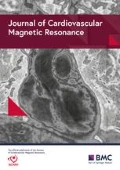Background
Displacement encoding with stimulated echoes (DENSE) is an accurate and reproducible [1, 2] technique for measuring myocardial strain throughout the cardiac cycle. The strain maps provided could be valuable in dilated cardiomyopathy (DCM) patients where strain has a prognostic value [3]. However, DENSE acquisitions typically require long breath holds which are difficult for DCM patients. In this work we accelerate DENSE acquisitions by selectively exciting a volume of tissue around the heart. This allows fewer spiral interleaves to be acquired without aliasing and, therefore a shorter breath hold.
Methods
A cine spiral DENSE sequence [4] was modified to selectively excite a reduced field of view. A slice selective gradient for the first and second RF pulses was added on the read and phase axes respectively (Figure 1). An improved excitation profile without increasing TE was achieved by making the 1st pulse asymmetric (peak at 81% of duration) and the 2nd pulse a time-reversed copy of the first.
Sequence schematic for the cine spiral DENSE sequence with zonal excitation (a). Example strain curves (b) and magnitude images (c) acquired in one example subject. Data from the long, medium and short acquisitions are shown as solid, dashed and dotted lines respectively. The coloured lines show the mean strain values from 6 equal angle segments and the black lines show the global short axis mean values. There is a good agreement between all three acquisitions.
In-vivo 2D cine DENSE was performed in 8 normal subjects (Siemens Skyra) in a mid short-axis slice. Images were acquired with variable flip angle (20° max), TE = 1 ms, fat suppression, 3.5 × 3.5 × 8 mm3 spatial resolution, 1282 matrix, 30 ms temporal resolution, 2 spirals/frame (6 ms/spirals), 2 direction encoding (+reference) at 0.06 cycles/mm, CSPAMM and through-plane dephasing artifact suppression. Long, medium and short acquisitions were performed with square field of view/breath hold duration of 360 mm/20RR-intervals (RR), 224 mm/14RR and 120 mm/8RR. The long acquisition used a similar field of view to previous work performed without the zonal excitation and was used as a reference [4]. Images were processed using the DENSE analysis tool from the University of Virginia [5].
Results
The figure shows example magnitude images (c) and strain curves (b) acquired using long, medium and short acquisitions. There is good agreement between the strain curves from all three acquisitions. Global peak strain, time to peak strain and the differences between acquisitions (long as reference, expressed as bias and root mean square error) are provided in the table for radial and circumferential strain. The differences between the three acquisitions are small. Medium and short breath hold acquisitions appear to be equally accurate.
Conclusions
Spiral cine DENSE imaging can be accelerated by up to a factor of 2.5 by selectively exciting and imaging a small field of view around the heart. The associated loss of signal to noise ratio is partly compensated for by imaging at 3T. This improvement allows 2D acquisitions to be performed in a short breath hold (~8s) which DCM patients could sustain. In future the same approach may be used to accelerate 3D spiral cine DENSE acquisitions.
References
Kim : Radiol. 2004, doi:10.1148/radiol.2303021213
Haggerty : JCMR. 2013, doi:10.1186/1532-429X-15-71
Buss : EHJ Imag. 2015, doi:10.1093/ehjci/jeu181
Zhong : MRM. 2010, doi:10.1002/mrm.22503
Spottiswoode : IEEE TMI. 2007, doi:10.1109/TMI.2006.884215
Author information
Authors and Affiliations
Rights and permissions
This article is published under an open access license. Please check the 'Copyright Information' section either on this page or in the PDF for details of this license and what re-use is permitted. If your intended use exceeds what is permitted by the license or if you are unable to locate the licence and re-use information, please contact the Rights and Permissions team.
About this article
Cite this article
Scott, A.D., Tayal, U., Nielles-Vallespin, S. et al. Accelerating cine DENSE using a zonal excitation. J Cardiovasc Magn Reson 18 (Suppl 1), O50 (2016). https://doi.org/10.1186/1532-429X-18-S1-O50
Published:
DOI: https://doi.org/10.1186/1532-429X-18-S1-O50


